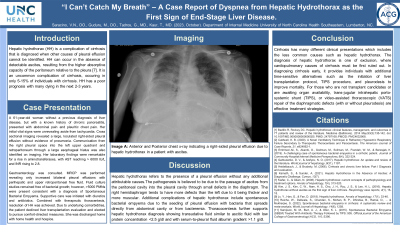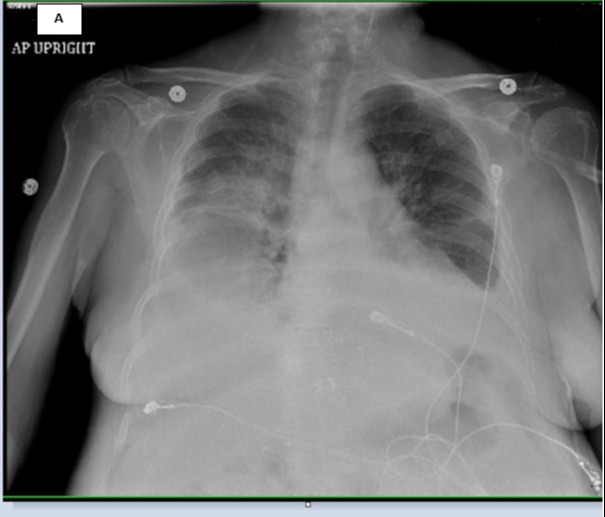Sunday Poster Session
Category: Liver
P1009 - I Can’t Catch My Breath - A Case Report of Dyspnea From Hepatic Hydrothorax as the First Sign of End Stage Liver Disease
Sunday, October 22, 2023
3:30 PM - 7:00 PM PT
Location: Exhibit Hall

Has Audio

Valentina N. Saracino, DO
Southeastern Regional Medical Center
Lumberton, NC
Presenting Author(s)
Valentina N. Saracino, DO, Manogna Guduru, DO, Gina Tadros, MD, Tarandeep Kaur, MD
Southeastern Regional Medical Center, Lumberton, NC
Introduction: Hepatic hydrothorax refers to the presence of pleural effusion in those with cirrhosis who do not have an explanation for the pleural effusion. Hepatic hydrothorax can occur without any detectable ascites, due to the higher absorptive capacity of the peritoneum as compared to the pleura [7]. It is relatively uncommon and occurs only in 5-15% of individuals with cirrhosis. Hepatic hydrothorax has a poor prognosis with many dying in the next 2-3 years.
Case Description/Methods: A 61-year-old woman without a previous diagnosis of liver disease, but with a known history of chronic pancreatitis presented with abdominal pain and pleuritic chest pain. Her initial vitals were unrevealing aside from tachycardia. Initial imaging showed a large, loculated right-sided pleural effusion without evidence of pneumonia. Additionally, CT findings showed fluid communicating from the right pleural space into the left upper quadrant and retroperitoneum through a large esophageal hiatus. Her laboratory findings were remarkable for a rise in LFTs with AST to the 6000s and INR rising to 2.8.
Gastroenterology was consulted and an MRCP performed showed only increased bilateral pleural effusions and perihepatic and upper retroperitoneal free fluid. Fluid studies were negative for culture, however, there were 5000 PMNs, indicating a diagnosis of Spontaneous Bacterial Empyema. Supportive care was implemented using diuretics, antibiotics, and fluid restriction, combined with therapeutic thoracentesis resulting in the resolution of hepatic hydrothorax. Due to her age and comorbidities, she declined liver transplantation and elected to transition to comfort care-only measures and be discharged home with home health.
Discussion: This report highlights the importance of recognizing different clinical presentations of cirrhosis and the importance of identifying less common causes such as hepatic hydrothorax. The diagnosis is one of exclusion, where cardiopulmonary causes of cirrhosis must be first ruled out. In diagnosing cirrhosis early, it provides individuals with additional time-sensitive alternatives such as the initiation of liver transplantation protocol, TIPS procedure, and pleurodesis to improve mortality. For those who are not transplant candidates or awaiting organ availability, trans-jugular intrahepatic Porto-systemic shunt (TIPS), or video-assisted thoracoscopic (VATS) repair of the diaphragmatic defects (with or without pleurodesis) are effective treatment strategies.

Disclosures:
Valentina N. Saracino, DO, Manogna Guduru, DO, Gina Tadros, MD, Tarandeep Kaur, MD. P1009 - I Can’t Catch My Breath - A Case Report of Dyspnea From Hepatic Hydrothorax as the First Sign of End Stage Liver Disease, ACG 2023 Annual Scientific Meeting Abstracts. Vancouver, BC, Canada: American College of Gastroenterology.
Southeastern Regional Medical Center, Lumberton, NC
Introduction: Hepatic hydrothorax refers to the presence of pleural effusion in those with cirrhosis who do not have an explanation for the pleural effusion. Hepatic hydrothorax can occur without any detectable ascites, due to the higher absorptive capacity of the peritoneum as compared to the pleura [7]. It is relatively uncommon and occurs only in 5-15% of individuals with cirrhosis. Hepatic hydrothorax has a poor prognosis with many dying in the next 2-3 years.
Case Description/Methods: A 61-year-old woman without a previous diagnosis of liver disease, but with a known history of chronic pancreatitis presented with abdominal pain and pleuritic chest pain. Her initial vitals were unrevealing aside from tachycardia. Initial imaging showed a large, loculated right-sided pleural effusion without evidence of pneumonia. Additionally, CT findings showed fluid communicating from the right pleural space into the left upper quadrant and retroperitoneum through a large esophageal hiatus. Her laboratory findings were remarkable for a rise in LFTs with AST to the 6000s and INR rising to 2.8.
Gastroenterology was consulted and an MRCP performed showed only increased bilateral pleural effusions and perihepatic and upper retroperitoneal free fluid. Fluid studies were negative for culture, however, there were 5000 PMNs, indicating a diagnosis of Spontaneous Bacterial Empyema. Supportive care was implemented using diuretics, antibiotics, and fluid restriction, combined with therapeutic thoracentesis resulting in the resolution of hepatic hydrothorax. Due to her age and comorbidities, she declined liver transplantation and elected to transition to comfort care-only measures and be discharged home with home health.
Discussion: This report highlights the importance of recognizing different clinical presentations of cirrhosis and the importance of identifying less common causes such as hepatic hydrothorax. The diagnosis is one of exclusion, where cardiopulmonary causes of cirrhosis must be first ruled out. In diagnosing cirrhosis early, it provides individuals with additional time-sensitive alternatives such as the initiation of liver transplantation protocol, TIPS procedure, and pleurodesis to improve mortality. For those who are not transplant candidates or awaiting organ availability, trans-jugular intrahepatic Porto-systemic shunt (TIPS), or video-assisted thoracoscopic (VATS) repair of the diaphragmatic defects (with or without pleurodesis) are effective treatment strategies.

Figure: Image A is upright chest x-ray (Anterior Posterior) indicating hepatic hydrothorax on the right side as well as spontaneous empyema.
Disclosures:
Valentina Saracino indicated no relevant financial relationships.
Manogna Guduru indicated no relevant financial relationships.
Gina Tadros indicated no relevant financial relationships.
Tarandeep Kaur indicated no relevant financial relationships.
Valentina N. Saracino, DO, Manogna Guduru, DO, Gina Tadros, MD, Tarandeep Kaur, MD. P1009 - I Can’t Catch My Breath - A Case Report of Dyspnea From Hepatic Hydrothorax as the First Sign of End Stage Liver Disease, ACG 2023 Annual Scientific Meeting Abstracts. Vancouver, BC, Canada: American College of Gastroenterology.
